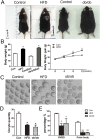Both diet and gene mutation induced obesity affect oocyte quality in mice
- PMID: 26732298
- PMCID: PMC4702149
- DOI: 10.1038/srep18858
Both diet and gene mutation induced obesity affect oocyte quality in mice
Abstract
Obesity was shown to cause reproductive dysfunctions such as reduced conception, infertility and early pregnancy loss. However, the possible effects of obesity on oocyte quality are still not fully understood. In this study we investigated the effects of both diet and gene mutation induced obesity on impairments in mouse oocyte polarization, oxidative stress, and epigenetic modifications. Our results showed that high-fat diet induced obesity (HFD) and gene mutation induced obesity (ob/ob) could both impair oocyte meiotic maturation, disrupt spindle morphology, and reduce oocyte polarity. Oocytes from obese mice underwent oxidative stress, as shown by high DHE and ROS levels. Abnormal mitochondrial distributions and structures were observed in oocytes from obese groups of mice and early apoptosis signals were detected, which suggesting that oxidative stress had impaired mitochondrial function and resulted in oocyte apoptosis. Our results also showed that 5 mC levels and H3K9 and H3K27 methylation levels were altered in oocytes from obese mice, which indicated that DNA methylation and histone methylation had been affected. Our results showed that both HFD and ob/ob induced obesity affected oocyte maturation and that oxidative stress-induced early apoptosis and altered epigenetic modifications may be the reasons for reduced oocyte quality in obese mice.
Figures





References
-
- Penzias A. S. Recurrent IVF failure: other factors. Fertil Steril 97, 1033–1038 (2012). - PubMed
-
- Chu S. Y. et al. Maternal obesity and risk of stillbirth: a metaanalysis. Am J Obstet Gynecol 197, 223–228 (2007). - PubMed
-
- Samuelsson A. M. et al. Diet-Induced Obesity in Female Mice Leads to Offspring Hyperphagia, Adiposity, Hypertension, and Insulin Resistance: A Novel Murine Model of Developmental Programming. Hypertension 51, 383–392 (2008). - PubMed
-
- Robker R. L. Evidence that obesity alters the quality of oocytes and embryos. Pathophysiology 15, 115–121 (2008). - PubMed
Publication types
MeSH terms
LinkOut - more resources
Full Text Sources
Other Literature Sources
Medical
Miscellaneous

